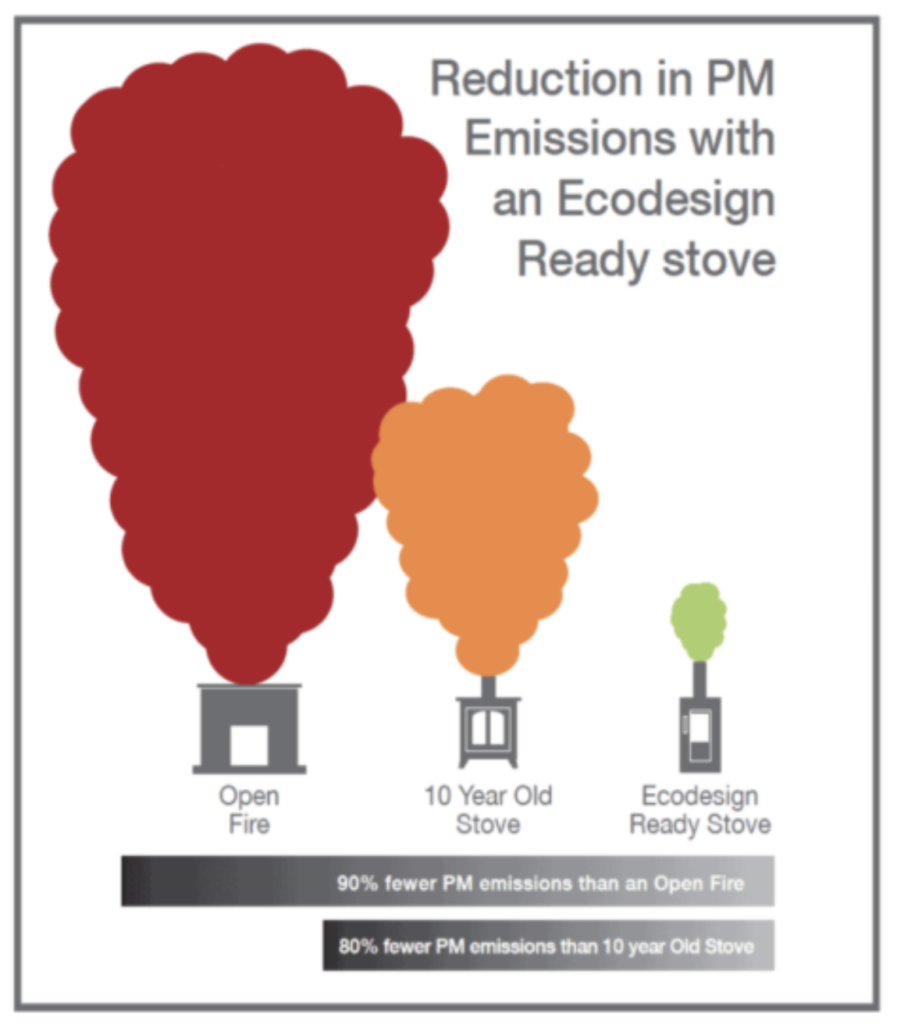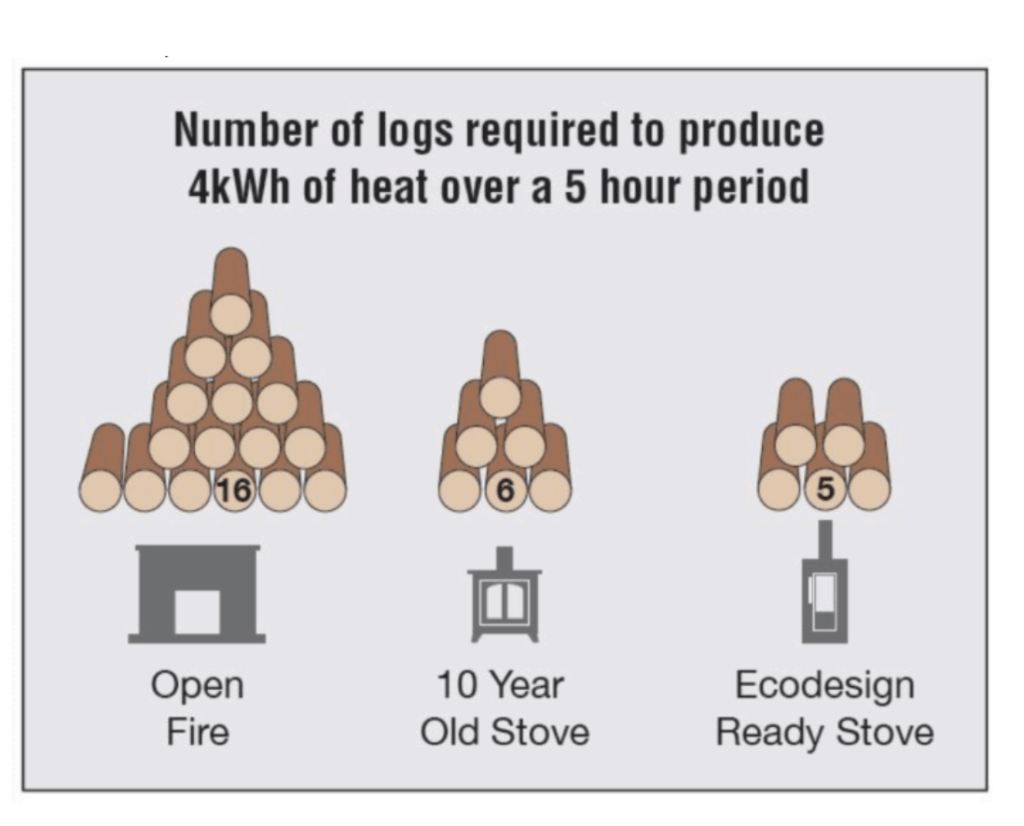The SIA (Stove Industry Alliance) have provided a useful insight into a study by Global Action Plan titled “Relight my fire? Investigating the true costs of wood burning stoves”.
Global Action Plan is an environmental charity that focuses on tackling air pollution and the root cause of climate change. This study looked at the use of woodburning stoves in the UK and imparticular looked at stoves against alternatives available in the context of current and future energy prices. The study undertook a simulation on a typical 3-bed London mid-terrace house which is double-glazed with loft insulation. The study looked at two scenarios:
1. A higher occupancy scenario – a family of four
2. A lower occupancy scenario based on a retired couple with no children at home where some rooms were unheated.

The simulation looked at a number of heating system options such as the home with 100% gas heating, the home with 80% gas heating and 20% wood-burning stove heating and so on.
There were five findings from this study:
Finding 1: They found little evidence that wood burners are a cheaper option, and in most cases are likely to be more expensive than the alternatives.
Finding 2: Only where a large majority of the wood fuel can be provided for free, are wood burners likely to save households money.
Finding 3: The health impacts and associated costs of wood-burning stoves are very significant, although again subject to large ranges.
Finding 4: The environmental impact of wood fuel is uncertain and is dependent on sustainably managed forestry. Heat pumps are likely to be a much greener option in the long term.
Finding 5: When factoring lifetime economic, environmental and health impact costs air source heat pumps are significantly lower cost than gas boilers, with wood-burning stoves significantly higher cost
SIA Response:
The SIA carefully reviewed this study and was keen to highlight some key points, which have been outlined below, reissued from the SIA website:
1. The model scenarios used in the study artificially inflate the costs associated with using a wood-burning stove and decrease the costs associated with an ASHP because;
Model B (see page 4 of the study) is based on “Newly Defra-compliant woodburning stove led heating (80%) with gas secondary heating (20%)”. In footnote 1 at the bottom of the page, it reads: “New” includes the cost of purchasing the item and installation, while all options include maintenance and replacement costs.” The SIA questions why if the purchase and installation costs have been factored in for the stove-led heating in Model B, they have not been factored in for the gas boiler-led heating, Model A?
Model B also assumes the installation and operation of TWO new stoves (see page 17 of the study). The SIA argues that this is a highly unlikely real-world scenario as a dry stove is a space heating appliance, not a central heating system.
Similarly, Model E “Newly installed Air Source Heat Pump (ASHP) providing 100% of heat” underestimates the actual running costs of the ASHP in the reference dwelling used (a Victorian mid-terrace of single skin, uninsulated solid brick construction, see page 15). Heat pumps are not suitable for use in badly insulated housing stock; they will not run optimally in these conditional optimally and therefore won’t give a 3.5 seasonal CoP which the report uses to reach its conclusions.
The calculations used in the study’s modelling assume that the efficiency and operational considerations of the heating system are met in situ. We know from studies on installed heating systems that the overall efficiency is negatively affected by the system it uses to distribute the heat within the property, e.g. the age and condition of pipework and radiations. The gas boiler and heat pump are affected by this whereas a direct heating appliance like a stove is not. The lack of consideration of this in the energy consumption calculations will positively skew the running costs for the boiler and ASHP against the more accurate running costs of the stove.
2. The energy efficiency of the appliance must also be considered when assessing cost-effectiveness. All solid fuel stoves manufactured since 1st January 2022 must conform to the Ecodesign Regulation which, as well as setting emissions levels, also states that the appliance must have a minimum efficiency of 75%. Many of the stoves manufactured by members of the SIA far exceed this, with tested efficiencies of over 80% and some achieving 85%. This is comparable with the most efficient gas roomheaters. While new gas boilers sold today achieve c.89% efficiency in practice, many older models will be less than 70% efficient. Local space heating is a key part of many individual’s heating strategies as you do not need to consider heating the whole house, just the space you want to heat. Stove owners value the off-grid, low-carbon heat that is provided by their stoves.
3. The SIA uses a range of sources to verify the comparative costs per kWh of various domestic heating fuels including the data presented by Nottingham Energy Partnership which is updated each month. The Partnership’s October 2023 data currently states the price per kWh of an ASHP as 12.37p, kiln-dried logs as 11.18p, mains gas at 8.64p and electricity at 33.40p. Between November 2022 and June 2023, kiln-dried wood logs were cheaper than mains gas per kWh.
There is sadly still a lot of negative press around wood-burning stoves, which if used correctly are sustainable, environmentally friendly and inexpensive to use. One main issue is that misinformed journalism does not always differentiate between the various ways you can burn wood. The diagram below, which we have used many times before gives an excellent insight into the emissions released by different wood-burning methods:

An Ecodesign stove releases some 90% fewer PM (particle matter) than an open fire and around 80% less than a non-Ecodesign stove 10+ years old. Open fires are incredibly inefficient, compared to an Ecodesign stove, as they draw room heat into the fire, which then disappears up the chimney. So, you then need to burn more wood for the same desired level of warmth – at the same time, the wood you are burning is subject to a much less efficient burn, compared to the Ecodesign stove. So, it’s essentially a double whammy. The diagram below demonstrates the differences between an Ecodesign stove and an open fire:

Burning firewood, if done so correctly, is highly environmentally friendly and sustainable as long as:
1. You’re sourcing wood from sustainable woodlands
2. You’re burning seasoned wood
3. You’re burning this seasoned wood on an Ecodesign stove
Woodlands MUST be sustainable. Here are a few key facts about woodlands and forests:
1. Forests cover around 30% of the world’s land area
2. Forests contain most of the world’s biodiversity and almost as much carbon as in the atmosphere
3. Directly and indirectly, forests and woodlands provide livelihoods for over one billion people
4. Forests influence the availability of water, regulate surface and groundwater flows, and also help maintain high water quality
5. Forests and trees reduce water-related risks such as landslides, floods and droughts
View our range of wood-burning stoves here.








